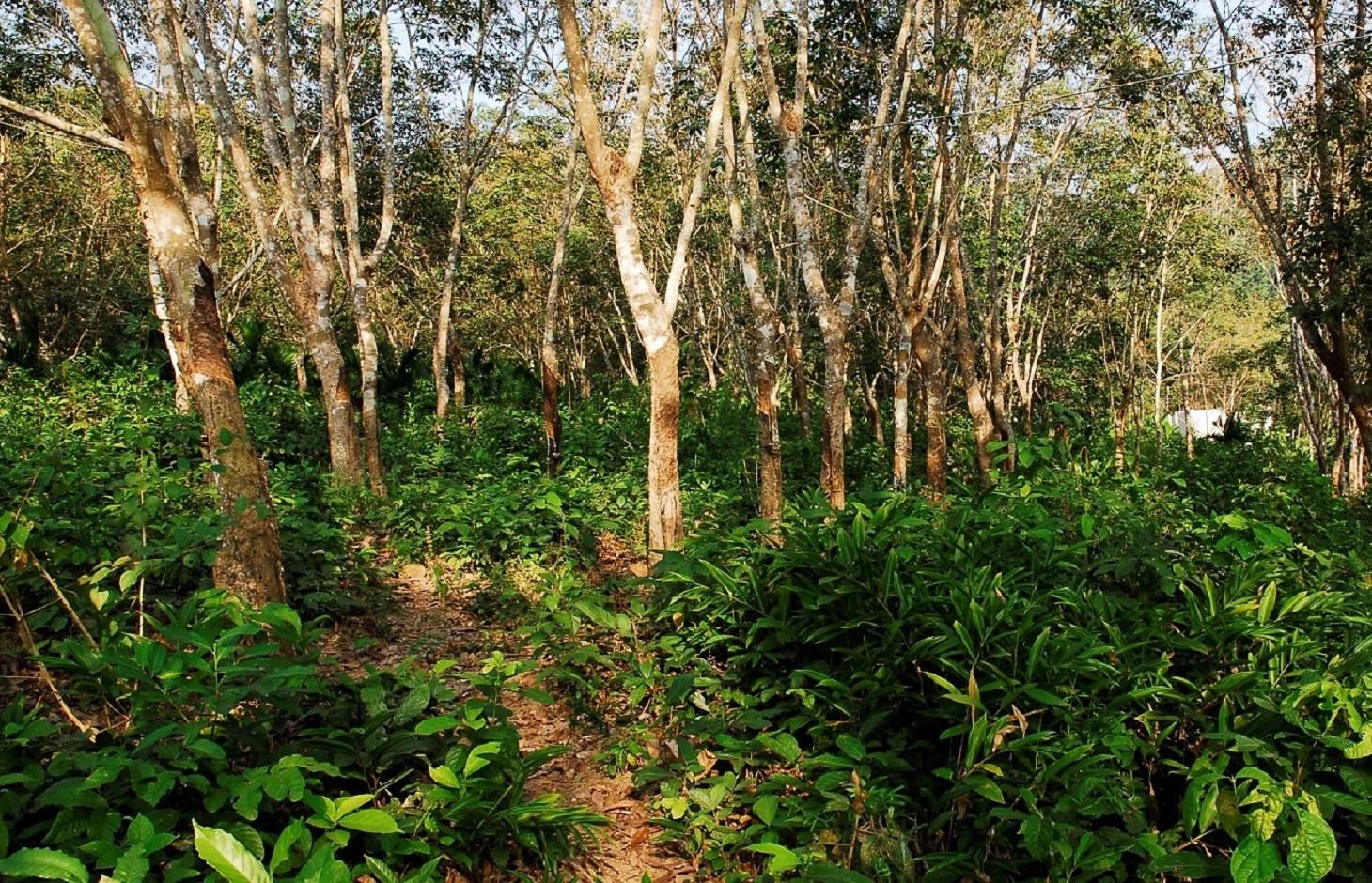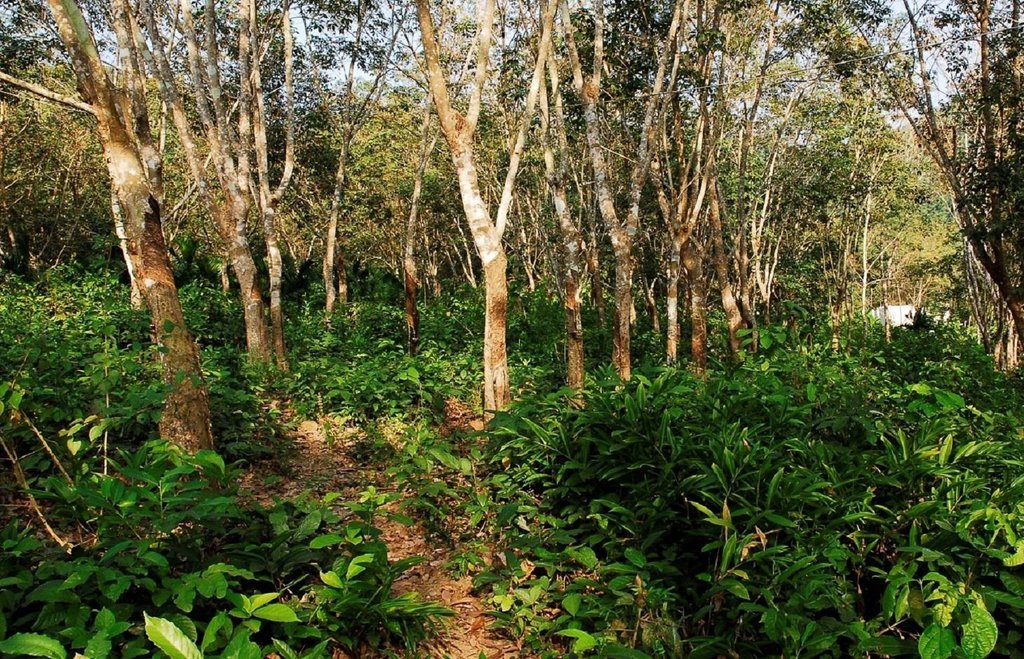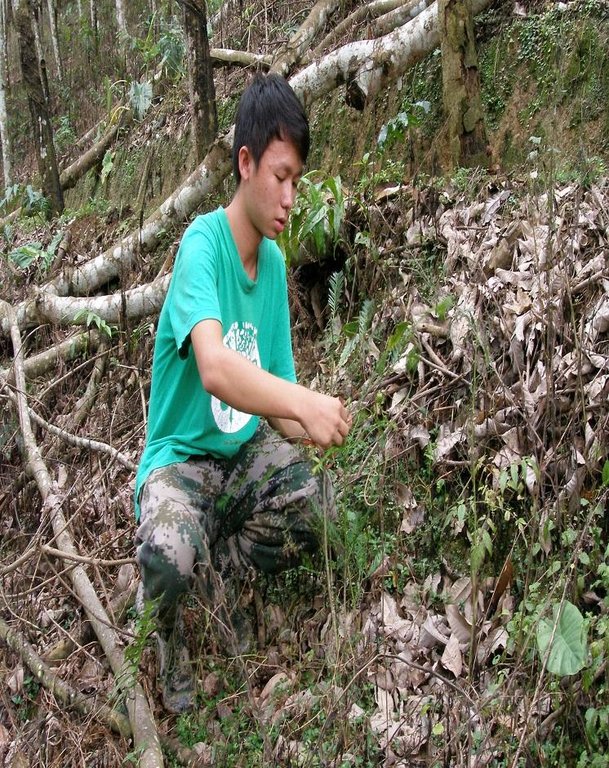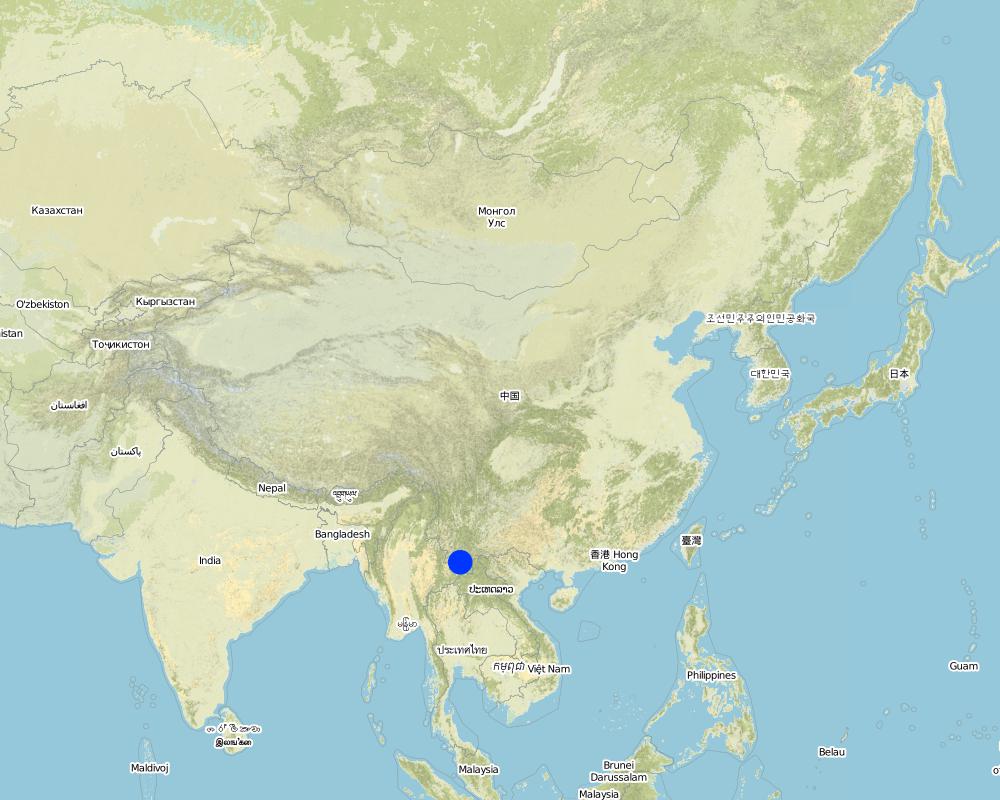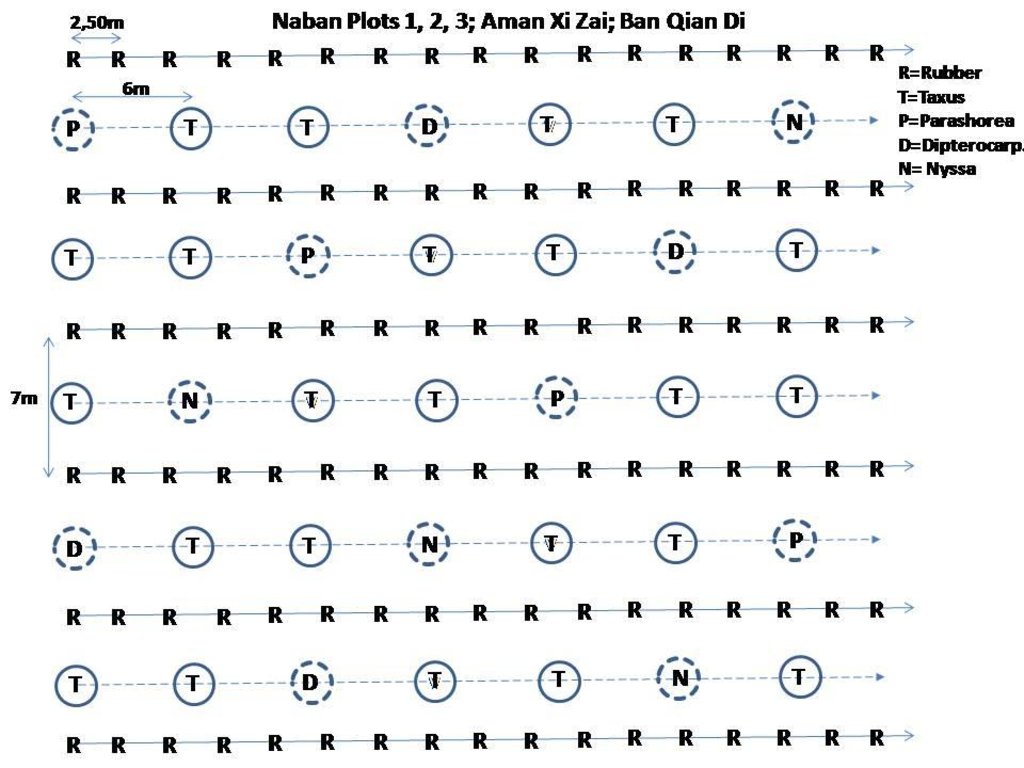Integrating native trees in rubber monocultures [จีน]
- ผู้สร้างสรรค์:
- การอัพเดท:
- ผู้รวบรวม: Gerhard Langenberger
- ผู้เรียบเรียง: –
- ผู้ตรวจสอบ: Deborah Niggli, Alexandra Gavilano
减缓单一橡胶种植的负面环境影响:关于橡胶与当地树种混种并结合杂草管理的生态种植研究 (Chinese)
technologies_1717 - จีน
ดูส่วนย่อย
ขยายทั้งหมด ย่อทั้งหมด1. ข้อมูลทั่วไป
1.2 รายละเอียดที่ติดต่อได้ของผู้รวบรวมและองค์กรที่เกี่ยวข้องในการประเมินและการจัดเตรียมทำเอกสารของเทคโนโลยี
ผู้เชี่ยวชาญ SLM:
ผู้เชี่ยวชาญ SLM:
Blagodatsky Sergey
University of Hohenheim
เยอรมนี
ชื่อของโครงการซึ่งอำนวยความสะดวกในการทำเอกสารหรือการประเมินเทคโนโลยี (ถ้าเกี่ยวข้อง)
Book project: Making sense of research for sustainable land management (GLUES)ชื่อขององค์กรซึ่งอำนวยความสะดวกในการทำเอกสารหรือการประเมินเทคโนโลยี (ถ้าเกี่ยวข้อง)
Humboldt Universität zu Berlin (HU Berlin) - เยอรมนีชื่อขององค์กรซึ่งอำนวยความสะดวกในการทำเอกสารหรือการประเมินเทคโนโลยี (ถ้าเกี่ยวข้อง)
Universität Hohenheim - เยอรมนีชื่อขององค์กรซึ่งอำนวยความสะดวกในการทำเอกสารหรือการประเมินเทคโนโลยี (ถ้าเกี่ยวข้อง)
China Agricultural University (China Agricultural University) - จีน1.3 เงื่อนไขการใช้ข้อมูลที่ได้บันทึกผ่านทาง WOCAT
ผู้รวบรวมและวิทยากรหลักยอมรับเงื่อนไขเกี่ยวกับการใช้ข้อมูลที่ถูกบันทึกผ่านทาง WOCAT:
ใช่
1.4 การเปิดเผยเรื่องความยั่งยืนของเทคโนโลยีที่ได้อธิบายไว้
เทคโนโลยีที่ได้อธิบายไว้นี้เป็นปัญหาของความเสื่อมโทรมโทรมของที่ดินหรือไม่ จึงไม่ได้รับการยอมรับว่าเป็นเทคโนโลยีเพื่อการจัดการที่ดินอย่างยั่งยืน:
ไม่ใช่
2. การอธิบายลักษณะของเทคโนโลยี SLM
2.1 การอธิบายแบบสั้น ๆ ของเทคโนโลยี
คำจำกัดความของเทคโนโลยี:
The technology combines the integration of native tree species into rubber monocultures with changed weed management to mitigate negative environmental impacts and to provide alternative income options for farmers.
2.2 การอธิบายแบบละเอียดของเทคโนโลยี
คำอธิบาย:
Natural rubber is a crucial renewable resource produced from the tree Hevea brasiliensis. Production is largely based on monoculture, often associated with chemical-based clean-weeding. This causes environmental problems such as loss of biodiversity, pesticide pollution and erosion of topsoil. The SLM-technology aims at mitigating negative impacts by interplanting the rubber with native tree species which have economic potential of their own. Changes in weed management are part of the package also.
Native (indigenous) tree species are integrated into mature rubber plantations. Criteria for species selection are: a) adapted to environmental conditions; b) shade tolerant; c) vertical growth not affected by light; d) conservation value; e) economic potential; f) easy to manage. Rubber trees are usually planted in rows at a spacing of 6-8 m, and an intra-row distance of 2.5 to 3 m. The native trees are planted between the rubber rows. The plantation should be mature as the canopy will have reached its highest density, and weed competition is naturally suppressed. The spacing of the native trees needs to be adapted to their growth potential and intended usage. After planting, regular monitoring is necessary to identify pests or diseases. The following species were selected for demonstration sites: 1) Parashorea chinensis, a valuable timber tree, 2) Taxus mairei, a multi-purpose tree, providing good timber but also an anti-cancer drug, taxol, and 3) Nyssa yunnanensis, selected for its conservation value. At the end of the economic life span of the rubber trees (about 30 years) there will be several options, but there are three main ones. First the rubber plantation can be replanted, although the harvest of the Parashorea chinensis trees would be premature. The Taxus mairei trees could be maintained through a new plantation cycle. Second, both, the rubber and the intercropped trees could be maintained for future timber and taxol production. Third, the plantation could be transformed into a sustainable forest managed scheme where the rubber trees are extracted step by step and the intercropped trees maintained for their intrinsic value.
Procedures for the selection and planting of the indigenous tree species are crucial. Identification should be based on suitability for the climate and soil as well as economic potential. The raising of tree seedlings requires experience and nursery propagation by experts might be required. Only healthy seedlings should be used. Planting should take place during rainy periods. Potted seedlings are better than bare-rooted seedlings since they establish better. Generally, weed management (if necessary) should shift from herbicide application to mechanical weeding. Grass competition needs to be avoided in any case! Controlled cover of natural undergrowth will reduce erosion and promote water infiltration.
The implementation site for the trials is located in Xishuangbanna Prefecture, Yunnan Province, SW China. The original vegetation was tropical rain and monsoon forest, but now there is a rich mosaic of different land-use and vegetation types. The whole region is exceptionally species rich and part of the Indo-Burma-Biodiversity Hotspot.
2.3 รูปภาพของเทคโนโลยี
2.5 ประเทศภูมิภาค หรือสถานที่ตั้งที่เทคโนโลยีได้นำไปใช้และได้รับการครอบคลุมโดยการประเมินนี้
ประเทศ:
จีน
ภูมิภาค/รัฐ/จังหวัด:
Xishuangbanna Dai Autonomous Prefecture, Yunnan Province, PR China
ข้อมูลจำเพาะเพิ่มเติมของสถานที่ตั้ง :
Naban River Watershed National Nature Reserve
ระบุการกระจายตัวของเทคโนโลยี:
- กระจายไปอย่างสม่ำเสมอในพื้นที่
If the Technology is evenly spread over an area, specify area covered (in km2):
0.03
แสดงความคิดเห็น:
Total area covered by the SLM Technology is 0.03 km2.
The technology is currently tested on three trial sites coveríng 3 ha. Some farmers started to adopt and also planted trees in rubber. But no figures are available so far.
Map
×2.6 วันที่การดำเนินการ
ถ้าไม่รู้ปีที่แน่นอน ให้ระบุวันที่โดยประมาณ:
- 10-50 ปี
2.7 คำแนะนำของเทคโนโลยี
- review on available knowledge on rubber management and history
ความคิดเห็น (ประเภทของโครงการ เป็นต้น) :
The technology is a result of the synthesis of research findings of the SURUMER-project and a review of available publications on rubber management.
3. การจัดประเภทของเทคโนโลยี SLM
3.1 วัตถุประสงค์หลักของเทคโนโลยี
- ปรับปรุงการผลิตให้ดีขึ้น
- อนุรักษ์ระบบนิเวศน์
- รักษาสภาพหรือปรับปรุงความหลากหลายทางชีวภาพ
3.2 ประเภทของการใช้ที่ดินในปัจจุบันที่ได้นำเทคโนโลยีไปใช้
Land use mixed within the same land unit:
ใช่
Specify mixed land use (crops/ grazing/ trees):
- วนเกษตร (Agroforestry)

พื้นที่ปลูกพืช
- การปลูกไม้ยืนต้น ไม้พุ่ม
Tree and shrub cropping - Specify crops:
- rubber
จำนวนของฤดูเพาะปลูกต่อปี:
- 1
ระบุ:
Longest growing period in days: 270, Longest growing period from month to month: April - December
แสดงความคิดเห็น:
Major land use problems (compiler’s opinion): Large-scale expansion of rubber monocultures results in the loss of topsoil and siltation of streams with respective consequences for CO2 emissions (increased), soil degradation, water quality and stream ecology. The excessive application of agrochemicals adds to these problems. The monoculture practice combined with clean weeding results in plant biodiversity loss. The related simplification of habitat structures also leads to a considerable decline in animal biodiversity.
Major land use problems (land users’ perception): The focus of land users is primarily on sustainable income, and their environmental concerns mainly relate to water provisioning (land user's point of view). In the farmers view: “The biggest environmental problem is water quantity. Rubber sucks out a lot of water, therefore we do have a water scarcity problem”. Farmers are aware of the contamination of drinking water due to the use of pesticides and herbicides in the rubber plantations.
Future (final) land use (after implementation of SLM Technology): Mixed: Mf: Agroforestry
Type of cropping system and major crops comments: The majority of farmers shifted to pure rubber growing, although many villages still have paddy rice fields.
3.4 การใช้น้ำ
การใช้น้ำของที่ดินที่มีการใช้เทคโนโลยีอยู่:
- น้ำฝนร่วมกับการชลประทาน
3.5 กลุ่ม SLM ที่ตรงกับเทคโนโลยีนี้
- การปลูกป่าร่วมกับพืช
3.6 มาตรการ SLM ที่ประกอบกันเป็นเทคโนโลยี

มาตรการอนุรักษ์ด้วยวิธีพืช
- V1: ต้นไม้และพุ่มไม้คลุมดิน

มาตรการอนุรักษ์ด้วยการจัดการ
- M2: การเปลี่ยนแปลงของการจัดการหรือระดับความเข้มข้น
3.7 รูปแบบหลักของการเสื่อมโทรมของที่ดินที่ได้รับการแก้ไขโดยเทคโนโลยี

การกัดกร่อนของดินโดยน้ำ
- Wt (Loss of topsoil): การสูญเสียดินชั้นบนหรือการกัดกร่อนที่ผิวดิน
- Wo (Offsite degradation): ผลกระทบนอกพื้นที่

การเสื่อมโทรมของดินทางด้านกายภาพ
- Pk (Slaking and crusting): การอุดตันของช่องว่างในดินหรือรูพรุน

การเสื่อมโทรมของดินทางด้านชีวภาพ
- Bc (Reduction of vegetation cover): การลดลงของจำนวนพืชที่ปกคลุมดิน
- Bh (Loss of habitat): การสูญเสียแหล่งที่อยู่
- Bs (Quality and species composition): องค์ประกอบหรือความหลากหลายทางคุณภาพและชนิดพันธุ์ลดลง

การเสื่อมโทรมของน้ำ
- Hs (Change in quantity of surface water): การเปลี่ยนแปลงปริมาณของน้ำที่ผิวดิน
- Hp (Decline of surface water quality): การลดลงของคุณภาพน้ำที่ผิวดิน
แสดงความคิดเห็น:
Main causes of degradation: deforestation / removal of natural vegetation (incl. forest fires) (Replacement of forests by monocultures.), poverty / wealth (Older people still have the memory of extreme poverty. Rubber was the main driver to reduce poverty; high profit gained by rubber encouraged people in pursuit of large scale monoculture.), inputs and infrastructure: (roads, markets, distribution of water points, other, …) (A tremendously improved infrastructure allows the establishment of plantations even in previously remote areas.), governance / institutional (Strong support from government in terms of subsidy and other incentives from 1980s to 2000s; subsidies are more recently reduced)
Secondary causes of degradation: crop management (annual, perennial, tree/shrub) (Clear-weeding, mainly with herbicides.), disturbance of water cycle (infiltration / runoff) (Removal of natural vegetation leads to higher runoff), land tenure (Introduction of Household Responsibility System in 1980s gave use-right to farmers. This pushed decisions on transformating natural forests to monocultures. No full property rights could hinder could), labour availability (Compared to the traditional agricultural system, rubber monocultures require less labour. Recently, there is even less labour available due to the relatively low income gained by rubber), education, access to knowledge and support services (The awareness about ecosystem services and functions is still poorly developed.), war and conflicts (Chinese government´s objective to be independent on important strategic resources such as rubber)
3.8 การป้องกัน การลดลง หรือการฟื้นฟูความเสื่อมโทรมของที่ดิน
ระบุเป้าหมายของเทคโนโลยีกับความเสื่อมโทรมของที่ดิน:
- ลดความเสื่อมโทรมของดิน
- ฟื้นฟูบำบัดที่ดินที่เสื่อมโทรมลงอย่างมาก
4. ข้อมูลจำเพาะด้านเทคนิค กิจกรรมการนำไปปฏิบัติใช้ ปัจจัยนำเข้า และค่าใช้จ่าย
4.1 แบบแปลนทางเทคนิคของเทคโนโลยี
ข้อมูลจำเพาะด้านเทคนิค (แบบแปลนทางเทคนิคของเทคโนโลยี):
The concept is based on the commonly suggested planting scheme of rubber with a row distance of ca. 7 m and a spacing of trees within the rows of ca. 2.5 to 3 m, resulting in ca. 450 to 500 trees/ha. The intercropping will take place between the rubber rows, on terraced slopes between the rubber terraces. Planting takes place after the plantations have reached half of their economic life span, which is ca. 15 years. It is important to consider that farmers often plant much denser than suggested by official guidelines, which needs an assessment of the light / shade conditions. With a too high rubber density the resulting light conditions might be too poor for intercropping even for forest trees. In our case the distance within a row of the intercropped trees has been set at 6 m, due to the (known) ecological characteristics of the selected 4 tree species. But the decision needs to be taken specifically for each new site, the potential tree species and the intentions of the land-user. Thus, in our case, we opted for a higher density of Taxus (bold circles) which is well known for its slow growth. and integrated the two other tree species at a wider distance (dotted circles).
Location: Yunnan Province, SW China. Xishuangbanna Prefecture
Date: September 2014
Technical knowledge required for field staff / advisors: high (The selection and management of native tree species requires a very good ecological as well as dendrological knowledge and understanding.)
Technical knowledge required for land users: moderate (If species selection has been successful and management is supported by a knowledgeable extension service.)
Main technical functions: control of dispersed runoff: retain / trap, stabilisation of soil (eg by tree roots against land slides), increase in organic matter, increase of infiltration, promotion of vegetation species and varieties (quality, eg palatable fodder)
Secondary technical functions: control of raindrop splash, improvement of surface structure (crusting, sealing), improvement of topsoil structure (compaction), increase / maintain water stored in soil, increase of groundwater level / recharge of groundwater
Aligned: -contour
Vegetative material: T : trees / shrubs
Vegetative measure: Intercropping of native tree species
Vegetative material: T : trees / shrubs
Number of plants per (ha): 240
Spacing between rows / strips / blocks (m): 7 m
Vertical interval within rows / strips / blocks (m): 6 m
Vegetative measure: Vegetative material: T : trees / shrubs
Trees/ shrubs species: Parashorea chinensis, Taxus mairei, Nyssa yunnanensis: all planted (container-planting)
Slope (which determines the spacing indicated above): 0-80%
Gradient along the rows / strips: 0%
Change of land use practices / intensity level: Shift from herbicide-based weed management to mechanical weeding with machine tools. This has not yet been implemented due lack of experience and proper tools.
ผู้เขียน:
G. Langenberger, Institute of Agricultural Sciences in the Tropics (490), University of Hohenheim, Germany
4.2 ข้อมูลทั่วไปเกี่ยวกับการคำนวณปัจจัยนำเข้าและค่าใช้จ่าย
อื่นๆ หรือสกุลเงินประจำชาติ (ระบุ):
RMB
If relevant, indicate exchange rate from USD to local currency (e.g. 1 USD = 79.9 Brazilian Real): 1 USD =:
6.3
ระบุค่าเฉลี่ยของค่าจ้างในการจ้างแรงงานต่อวัน:
16.00
4.3 กิจกรรมเพื่อการจัดตั้ง
| กิจกรรม | Timing (season) | |
|---|---|---|
| 1. | 1.Seedling acquisition and transport | before or during rainy season |
| 2. | 2.Planting of seedlings in rainy season | rainy season |
| 3. | Weed management with brush cutters. | ? no experience |
4.4 ค่าใช้จ่ายของปัจจัยนำเข้าที่จำเป็นสำหรับการจัดตั้ง
| ปัจจัยนำเข้า | หน่วย | ปริมาณ | ค่าใช้จ่ายต่อหน่วย | ค่าใช้จ่ายทั้งหมดต่อปัจจัยนำเข้า | %ของค่าใช้จ่ายที่ก่อให้เกิดขึ้นโดยผู้ใช้ที่ดิน | |
|---|---|---|---|---|---|---|
| แรงงาน | labour | ha | 1.0 | 80.0 | 80.0 | 100.0 |
| อุปกรณ์ | machine use | ha | 1.0 | 80.0 | 80.0 | |
| อุปกรณ์ | animal traction | ha | 1.0 | 8.0 | 8.0 | 100.0 |
| วัสดุด้านพืช | seedlings | ha | 1.0 | 2400.0 | 2400.0 | |
| ค่าใช้จ่ายทั้งหมดของการจัดตั้งเทคโนโลยี | 2568.0 | |||||
| Total costs for establishment of the Technology in USD | 407.62 | |||||
แสดงความคิดเห็น:
Duration of establishment phase: 0.07 month(s)
4.5 การบำรุงรักษาสภาพหรือกิจกรรมที่เกิดขึ้นเป็นประจำ
| กิจกรรม | ช่วงระยะเวลา/ความถี่ | |
|---|---|---|
| 1. | 1.Control of pests and diseases | monthly |
4.6 ค่าใช้จ่ายของปัจจัยนำเข้าและกิจกรรมที่เกิดขึ้นเป็นประจำที่ต้องการการบำรุงรักษา (ต่อปี)
| ปัจจัยนำเข้า | หน่วย | ปริมาณ | ค่าใช้จ่ายต่อหน่วย | ค่าใช้จ่ายทั้งหมดต่อปัจจัยนำเข้า | %ของค่าใช้จ่ายที่ก่อให้เกิดขึ้นโดยผู้ใช้ที่ดิน | |
|---|---|---|---|---|---|---|
| แรงงาน | labour | ha | 1.0 | 96.0 | 96.0 | 100.0 |
| ค่าใช้จ่ายทั้งหมดของการบำรุงรักษาสภาพเทคโนโลยี | 96.0 | |||||
| Total costs for maintenance of the Technology in USD | 15.24 | |||||
แสดงความคิดเห็น:
The costs are based on the establishment of 3 demonstration plots of ca. 1 ha each. It should be possible to considerably reduce the costs by producing seedlings on site.
4.7 ปัจจัยสำคัญที่สุดที่มีผลกระทบต่อค่าใช้จ่าย
ปัจจัยสำคัญที่สุดที่มีผลกระทบต่อค่าใช้จ่ายต่างๆ:
Seedling costs are by far the major cost factor. Since the selected species are very unusual and don't have a considerable market they were extremely expensive. Since Taxus is also a reputed medicinal plant, it might also have influenced the price. All other costs are actually negligible compared to the costs of the seedlings. In this case the establishment of an own nursery might considerably reduce the costs, since propagation at least of Taxus and Parashorea is easy if the seeds can be acquired.
5. สิ่งแวดล้อมทางธรรมชาติและของมนุษย์
5.1 ภูมิอากาศ
ฝนประจำปี
- < 250 ม.ม.
- 251-500 ม.ม.
- 501-750 ม.ม.
- 751-1,000 ม.ม.
- 1,001-1,500 ม.ม.
- 1,501-2,000 ม.ม.
- 2,001-3,000 ม.ม.
- 3,001-4,000 ม.ม.
- > 4,000 ม.ม.
เขตภูมิอากาศเกษตร
- กึ่งชุ่มชื้น
Thermal climate class: subtropics
5.2 สภาพภูมิประเทศ
ค่าเฉลี่ยความลาดชัน:
- ราบเรียบ (0-2%)
- ลาดที่ไม่ชัน (3-5%)
- ปานกลาง (6-10%)
- เป็นลูกคลื่น (11-15%)
- เป็นเนิน (16-30%)
- ชัน (31-60%)
- ชันมาก (>60%)
ธรณีสัณฐาน:
- ที่ราบสูง/ที่ราบ
- สันเขา
- ไหล่เขา
- ไหล่เนินเขา
- ตีนเนิน
- หุบเขา
ระดับความสูง:
- 0-100 เมตร
- 101-500 เมตร
- 501-1,000 เมตร
- 1,001-1,500 เมตร
- 1,501-2,000 เมตร
- 2,001-2,500 เมตร
- 2,501-3,000 เมตร
- 3,001-4,000 เมตร
- > 4,000 เมตร
5.3 ดิน
ค่าเฉลี่ยความลึกของดิน:
- ตื้นมาก (0-20 ซ.ม.)
- ตื้น (21-50 ซ.ม.)
- ลึกปานกลาง (51-80 ซ.ม.)
- ลึก (81-120 ซ.ม.)
- ลึกมาก (>120 ซ.ม.)
เนื้อดิน (ดินชั้นบน):
- ปานกลาง (ดินร่วน ทรายแป้ง)
- ละเอียด/หนัก (ดินเหนียว)
อินทรียวัตถุในดิน:
- ปานกลาง (1-3%)
5.4 ความเป็นประโยชน์และคุณภาพของน้ำ
น้ำไหลบ่าที่ผิวดิน:
ดี
คุณภาพน้ำ (ที่ยังไม่ได้บำบัด):
เป็นน้ำเพื่อการดื่มที่ไม่ดี (จำเป็นต้องได้รับการบำบัด)
5.5 ความหลากหลายทางชีวภาพ
ความหลากหลายทางชนิดพันธุ์:
- สูง
5.6 ลักษณะของผู้ใช้ที่ดินที่นำเทคโนโลยีไปปฏิบัติใช้
แนวทางการตลาดของระบบการผลิต:
- ทำการค้า/การตลาด
รายได้ที่มาจากนอกฟาร์ม:
- 10-50% ของรายได้ทั้งหมด
ระดับของความมั่งคั่งโดยเปรียบเทียบ:
- จน
- พอมีพอกิน
เป็นรายบุคคล/ครัวเรือน:
- เป็นรายบุคคล/ครัวเรือน
ระดับของการใช้เครื่องจักรกล:
- งานที่ใช้แรงกาย
เพศ:
- ชาย
ระบุลักษณะอื่นๆที่เกี่ยวข้องของผู้ใช้ที่ดิน:
Land users applying the Technology are mainly Leaders / privileged
Difference in the involvement of women and men: So far, the number of persons applying the technology is still too low to draw any meaningful conclusion.
Population density: 10-50 persons/km2
Annual population growth: < 0.5% (farmers have been well off in the past, currently they are under pressure due to the very low rubber).
5.7 Average area of land used by land users applying the Technology
- < 0.5 เฮกตาร์
- 0.5-1 เฮกตาร์
- 1-2 เฮกตาร์
- 2-5 เฮกตาร์
- 5-15 เฮกตาร์
- 15-50 เฮกตาร์
- 50-100 เฮกตาร์
- 100-500 เฮกตาร์
- 500-1,000 เฮกตาร์
- 1,000-10,000 เฮกตาร์
- >10,000 เฮกตาร์
พิจารณาว่าเป็นขนาดเล็ก กลาง หรือขนาดใหญ่ (ซึ่งอ้างอิงถึงบริบทระดับท้องถิ่น):
- ขนาดเล็ก
5.8 กรรมสิทธิ์ในที่ดิน สิทธิในการใช้ที่ดินและสิทธิในการใช้น้ำ
กรรมสิทธิ์ในที่ดิน:
- รัฐ
สิทธิในการใช้ที่ดิน:
- รายบุคคล
แสดงความคิดเห็น:
Water use rights seem to be an issue.
5.9 การเข้าถึงบริการและโครงสร้างพื้นฐาน
สุขภาพ:
- จน
- ปานกลาง
- ดี
การศึกษา:
- จน
- ปานกลาง
- ดี
ความช่วยเหลือทางด้านเทคนิค:
- จน
- ปานกลาง
- ดี
การจ้างงาน (เช่น ภายนอกฟาร์ม):
- จน
- ปานกลาง
- ดี
ตลาด:
- จน
- ปานกลาง
- ดี
พลังงาน:
- จน
- ปานกลาง
- ดี
ถนนและการขนส่ง:
- จน
- ปานกลาง
- ดี
น้ำดื่มและการสุขาภิบาล:
- จน
- ปานกลาง
- ดี
6. ผลกระทบและสรุปคำบอกกล่าว
6.1 ผลกระทบในพื้นที่ดำเนินการ (On-site) จากการใช้เทคโนโลยี
ผลกระทบทางด้านเศรษฐกิจและสังคม
การผลิต
การผลิตไม้
แสดงความคิดเห็น/ระบุ:
considerably, but no experience
รายได้และค่าใช้จ่าย
ภาระงาน
แสดงความคิดเห็น/ระบุ:
no practical experience, yet
ผลกระทบด้านสังคมวัฒนธรรมอื่น ๆ
การบรรเทาความขัดแย้ง
ผลกระทบด้านนิเวศวิทยา
วัฐจักรน้ำหรือน้ำบ่า
คุณภาพน้ำ
แสดงความคิดเห็น/ระบุ:
less erosion
น้ำไหลบ่าที่ผิวดิน
แสดงความคิดเห็น/ระบุ:
cf. Hongxi
ดิน
สิ่งปกคลุมดิน
แสดงความคิดเห็น/ระบุ:
compared to clear-weeding
ความหลากหลายทางชีวภาพของพืชและสัตว์
มวลชีวภาพ/เหนือดินชั้น C
แสดงความคิดเห็น/ระบุ:
cf. Xueqing
6.2 ผลกระทบนอกพื้นที่ดำเนินการ (Off-site) จากการใช้เทคโนโลยี
การทับถมของดินตะกอนพื้นที่ท้ายน้ำ
การเกิดมลพิษในน้ำบาดาลหรือแม่น้ำ
ความสามารถต้านทานการเปลี่ยนแปลง / ความสามารถในการคัดกรอง
6.3 การเผชิญและความตอบสนองของเทคโนโลยีต่อการเปลี่ยนแปลงสภาพภูมิอากาศที่ค่อยเป็นค่อยไป และสภาพรุนแรงของภูมิอากาศ / ภัยพิบัติ (ที่รับรู้ได้โดยผู้ใช้ที่ดิน)
การเปลี่ยนแปลงสภาพภูมิอากาศที่ค่อยเป็นค่อยไป
การเปลี่ยนแปลงสภาพภูมิอากาศที่ค่อยเป็นค่อยไป
| ฤดู | increase or decrease | เทคโนโลยีมีวิธีการรับมืออย่างไร | |
|---|---|---|---|
| อุณหภูมิประจำปี | เพิ่มขึ้น | ดี |
สภาพรุนแรงของภูมิอากาศ (ภัยพิบัติ)
ภัยพิบัติทางอุตุนิยมวิทยา
| เทคโนโลยีมีวิธีการรับมืออย่างไร | |
|---|---|
| พายุฝนประจำท้องถิ่น | ดี |
| พายุลมประจำท้องถิ่น | ไม่ทราบ |
ภัยพิบัติจากสภาพภูมิอากาศ
| เทคโนโลยีมีวิธีการรับมืออย่างไร | |
|---|---|
| ภัยจากฝนแล้ง | ไม่ค่อยดี |
ภัยพิบัติจากน้ำ
| เทคโนโลยีมีวิธีการรับมืออย่างไร | |
|---|---|
| น้ำท่วมตามปกติ (แม่น้ำ) | ไม่ทราบ |
ผลลัพธ์ตามมาที่เกี่ยวข้องกับภูมิอากาศอื่น ๆ
ผลลัพธ์ตามมาที่เกี่ยวข้องกับภูมิอากาศอื่น ๆ
| เทคโนโลยีมีวิธีการรับมืออย่างไร | |
|---|---|
| ช่วงการปลูกพืชที่ลดลงมา | ไม่ค่อยดี |
| cold spells | ไม่ค่อยดี |
แสดงความคิดเห็น:
The above assessment is based on the fact that we are actually dealing with plants adapted to tropical conditions. Therefore, the species should be less affected by high temperatures and increasing rainfall, but might be sensitive to droughts. Nevertheless, there is no experience!
6.4 การวิเคราะห์ค่าใช้จ่ายและผลประโยชน์ที่ได้รับ
ผลประโยชน์ที่ได้รับเปรียบเทียบกับค่าใช้จ่ายในการจัดตั้งเป็นอย่างไร (จากมุมมองของผู้ใช้ที่ดิน)
ผลตอบแทนระยะสั้น:
ด้านลบ
ผลตอบแทนระยะยาว:
ด้านบวก
ผลประโยชน์ที่ได้รับเปรียบเทียบกับค่าใช้จ่ายในการบำรุงรักษาหรือต้นทุนที่เกิดขึ้นซ้ำอีก เป็นอย่างไร (จากมุมมองของผู้ใช้ที่ดิน)
ผลตอบแทนระยะสั้น:
ด้านบวก
ผลตอบแทนระยะยาว:
ด้านบวกอย่างมาก
แสดงความคิดเห็น:
The establishment costs for the demo-sites have been very high, but could be considerably reduced if adopted by more farmers. The assessment above therefore needs verification!
6.5 การปรับตัวของเทคโนโลยี
แสดงความคิดเห็น:
100% of land user families have adopted the Technology with external material support
3 land user families have adopted the Technology with external material support
There is a little trend towards spontaneous adoption of the Technology. Comments on adoption trend: We experienced interest in the technology by farmers, but due to the lack of experience and the lack of affordable and accessible seedlings they are hesitant.
6.7 จุดแข็ง / ข้อได้เปรียบ / โอกาสของเทคโนโลยี
| จุดแข็ง / ข้อได้เปรียบ / โอกาสในทัศนคติของผู้ใช้ที่ดิน |
|---|
| Additional income options. |
| จุดแข็ง / ข้อได้เปรียบ / โอกาสในทัศนคติของผู้รวบรวมหรือวิทยากรหลัก |
|---|
| The technology offers considerable long-term advantageous to farmers. It diversifies the product portfolio and good options for additional income in the future. Beyond the establishment it doesn't require much labour. |
6.8 จุดอ่อน / ข้อเสียเปรียบ / ความเสี่ยงของเทคโนโลยีและวิธีการแก้ไข
| จุดอ่อน / ข้อเสียเปรียบ / ความเสี่ยงในทัศนคติของผู้ใช้ที่ดิน | มีวิธีการแก้ไขได้อย่างไร |
|---|---|
| High investment costs. | Government subsidies. |
| Time until first returns can be expected. 5-10 years for taxol production |
| จุดอ่อน / ข้อเสียเปรียบ / ความเสี่ยงในทัศนคติของผู้รวบรวมหรือวิทยากรหลัก | มีวิธีการแก้ไขได้อย่างไร |
|---|---|
| The technology is based on a long-term perspective and thus favours farmers who have a such an outlook. But farmers with little land usually think short-term. | The current trend of rural-urban migration will support the technology since it can be easily combined with off-farm work. According to SURUMER findings off-farm income already contributes about one third of the overall household income in the rubber growing areas. |
| Current establishment costs are very high due to the lack of a seedling market. | If the technology becomes known and popular, more nurseries will produce seedlings which will reduce costs. Alternatively, farmers might establish their individual (or community) nurseries. |
| The technology requires considerable knowledge about tree ecology and tree breeding. | There should be extension officers at the local agricultural or forestry bureaus supporting farmers. |
7. การอ้างอิงและการเชื่อมต่อ
7.1 วิธีการและแหล่งข้อมูล
- ไปเยี่ยมชมภาคสนาม การสำรวจพื้นที่ภาคสนาม
- การสัมภาษณ์กับผู้ใช้ที่ดิน
วันที่เก็บรวบรวมข้อมูล(ภาคสนาม) :
12/02/2016
7.2 การอ้างอิงถึงสิ่งตีพิมพ์
หัวข้อ, ผู้เขียน, ปี, หมายเลข ISBN:
Ahrends, A. et al. (2015) Current trends of rubber plantation expansion may threaten biodiversity and livelihoods
ชื่อเรื่อง ผู้เขียน ปี ISBN:
Global Environ Change, 34, 48-58.
หัวข้อ, ผู้เขียน, ปี, หมายเลข ISBN:
Langenberger, G. et al. (2016) Rubber intercropping: a viable concept for the 21st century?
ชื่อเรื่อง ผู้เขียน ปี ISBN:
Agrofor Syst, 1-20.
หัวข้อ, ผู้เขียน, ปี, หมายเลข ISBN:
Liu, H. et al. (2016) Impact of herbicide application on soil erosion and induced carbon loss in a rubber plantation of Southwest China
ชื่อเรื่อง ผู้เขียน ปี ISBN:
CATENA, 145, 180-192.
ลิงก์และโมดูล
ขยายทั้งหมด ย่อทั้งหมดลิงก์
ไม่มีลิงก์
โมดูล
ไม่มีโมดูล


